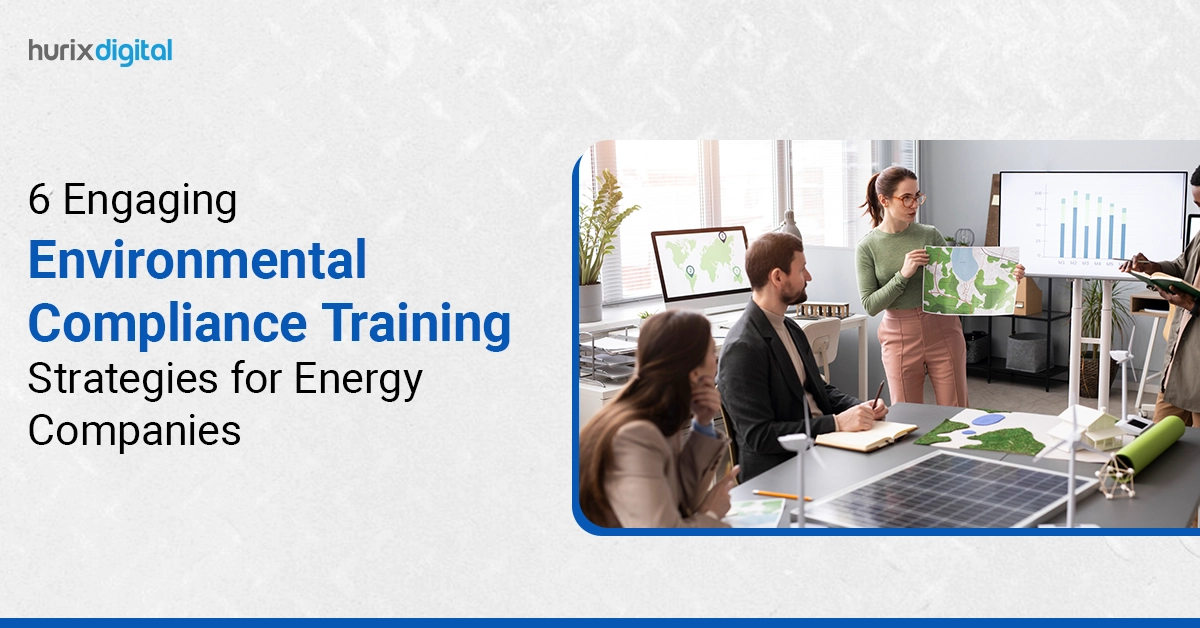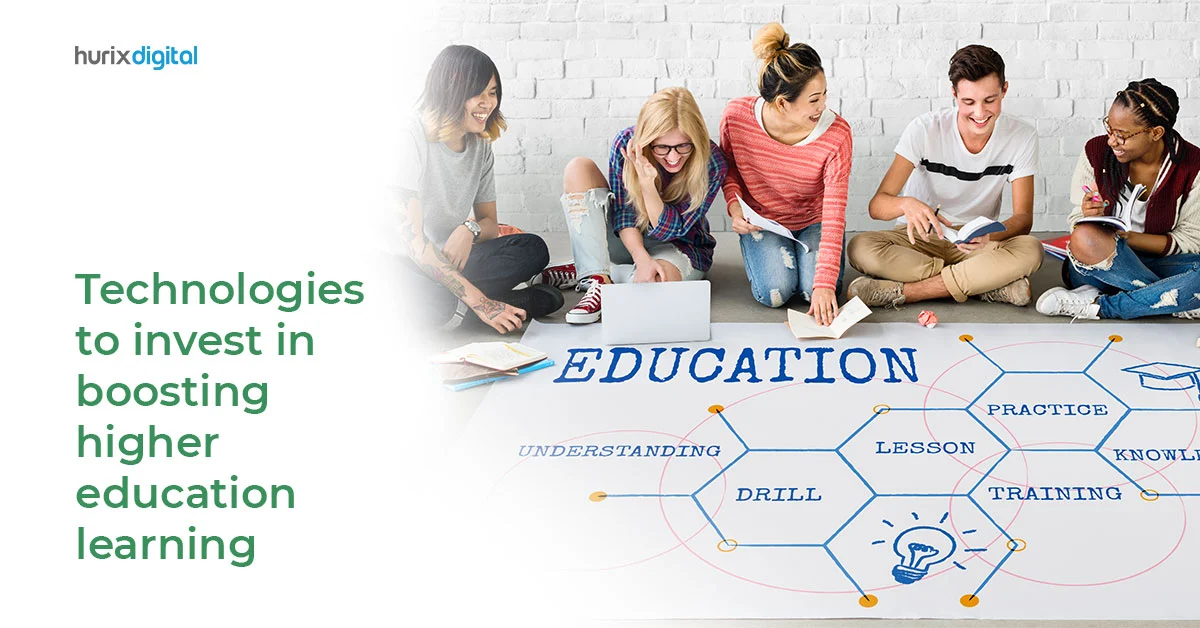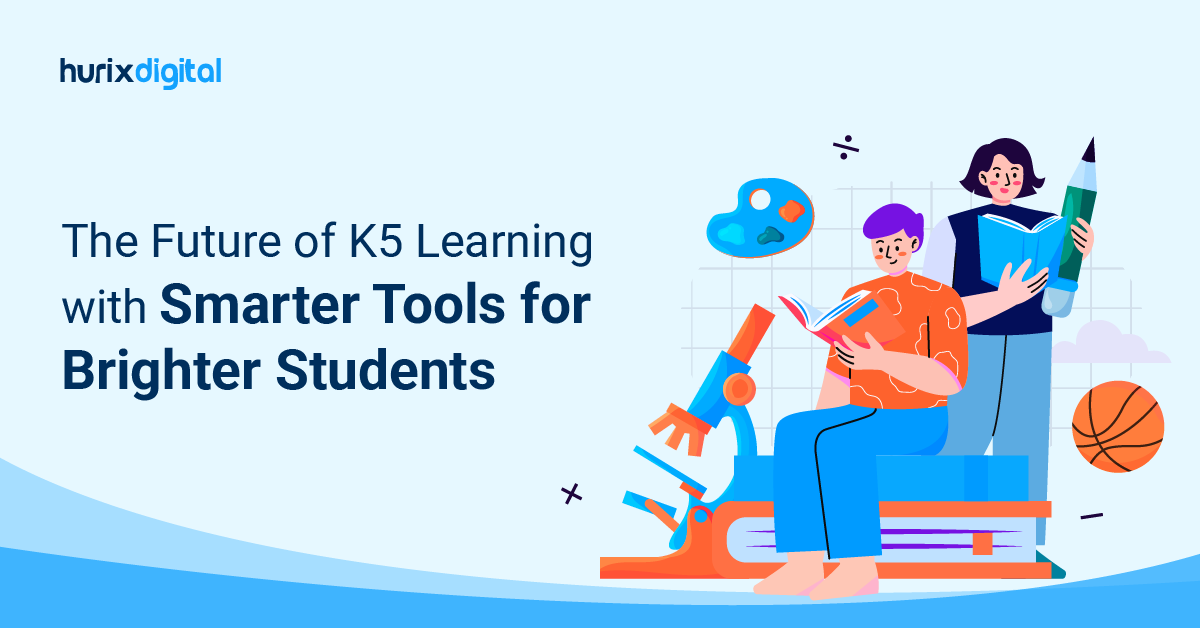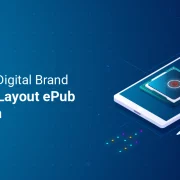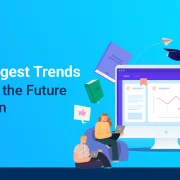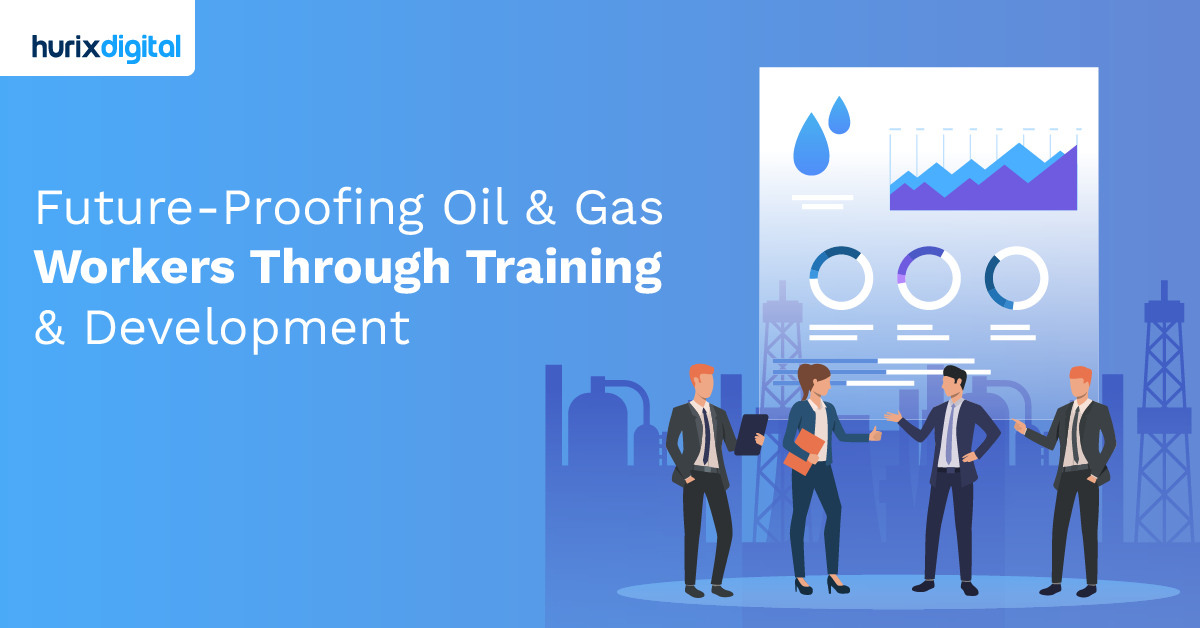
Future-Proofing Oil & Gas Workers Through Training & Development
Summary
The oil and gas industry is changing and needs a skilled workforce to tackle new energy challenges. This guide looks at affordable training for sustainability, the importance of soft skills, and ways to help workers transition. Find out how to give employees the right skills to succeed in the changing energy sector.
For instance, there’s a growing demand that companies adopt the best sustainable procurement practices. These practices aim to help companies balance operational costs with environmental responsibility. Companies making early investments in the digital training of their workforces can execute sustainability goals cost-effectively.
Driven by concerns about sustainability, countries and businesses are adopting renewable energy sources at an increasing rate. Projections estimate that these sources will account for half of the global energy mix by 2050.
This rearrangement presents a critical challenge for the oil & gas industry, demanding a skilled and adaptable workforce primed to succeed in this evolving environment.
Workforce transformation is indispensable for oil and gas companies, given the demands of the rapidly changing energy industry and the need to close the emerging skills gap.
Read on as we explore how companies are implementing comprehensive reskilling and upskilling programs to equip their workforce with expertise in renewable energy technologies and sustainable practices.
Table of Contents:
- Understanding the Energy Transition
- What is Sustainable Procurement Workforce Training?
- Importance of Sustainable Sourcing Strategies in the Oil and Gas Sector
- 7 Key Sustainable Sourcing Workforce Training Strategies
- The Challenge: Skills Gap and Changing Needs
- What is Soft Skills Training?
- Importance of Soft Skills Training for Oil and Gas Professionals
- Essential Soft Skills for Engineers in the Oil and Gas Industry
- Industry-Specific Soft Skills for Oil and Gas Employee Training
- How to Enhance Soft Skills Development through Oil and Gas Employee Training Programs?
- Best Practices for Soft Skills in Oil & Gas
- Strategies for a Future-Ready Energy Workforce
- Wrapping Up
Understanding the Energy Transition
The transition to cleaner energy extends a compelling opportunity for job creation. In a major report, the International Energy Agency (IEA) predicts over 30 million fresh jobs in the green energy sector by 2030.
The employment market for fossil fuels will contract in tandem with this increase, especially in sectors like coal supply, which are experiencing significant downsizing as a result of decarbonization and automation. Proactive workforce transformation is necessary to capitalize on opportunities elicited by a low-carbon energy future.
This workforce training process is already underway for businesses and employees looking to acquire a competitive edge. Fortunately, most current energy experts are well-positioned to move to cleaner energy sources.
The good news is that most energy experts now in employment are qualified to switch to cleaner energy sources.
According to a recent Robert Gordon University study, more than 90% of UK workers in the oil and gas industry have transferable skills highly applicable to positions in renewable energy. These transferable abilities, including project management, knowledge of engineering and health and safety procedures, and experience servicing and maintaining complicated systems, are all valuable assets in the renewable energy industry.
What is Sustainable Procurement Workforce Training?
Sustainable procurement workforce training is a structured approach toward skilling employees in the most cost-effective and environmentally friendly supply chain management practices.
In the context of oil and gas companies, the training must empower teams to apply sustainable processes in procuring raw materials. These practices can ensure limited environmental damage. Simultaneously, cost and Return On Investment (ROI) are important in ensuring that companies function optimally and become profitable.
Embracing digital training can help businesses execute training quickly, effectively, and at scale.
Importance of Sustainable Sourcing Strategies in the Oil and Gas Sector
Though the demand for renewable energy is rising, the global energy mix in 2025 is estimated to comprise 48% of fossil fuels. However, oil and gas companies must strive to reduce their carbon footprint. One approach is to adopt sustainable procurement best practices that comply with Environmental, Social, and Governance (ESG) frameworks.
Complying with ESG frameworks is an important goal of forward-thinking oil and gas companies. By doing so, businesses can attract more investors, forge critical partnerships, and access rewards such as sustainability tax credits. They will be able to mitigate financial and business sustainability risks.
Hence, investments in cost-effective sustainability training are emerging as the need of the hour. By delivering timely training, businesses can innovate and reap the benefits of being ESG-compliant.
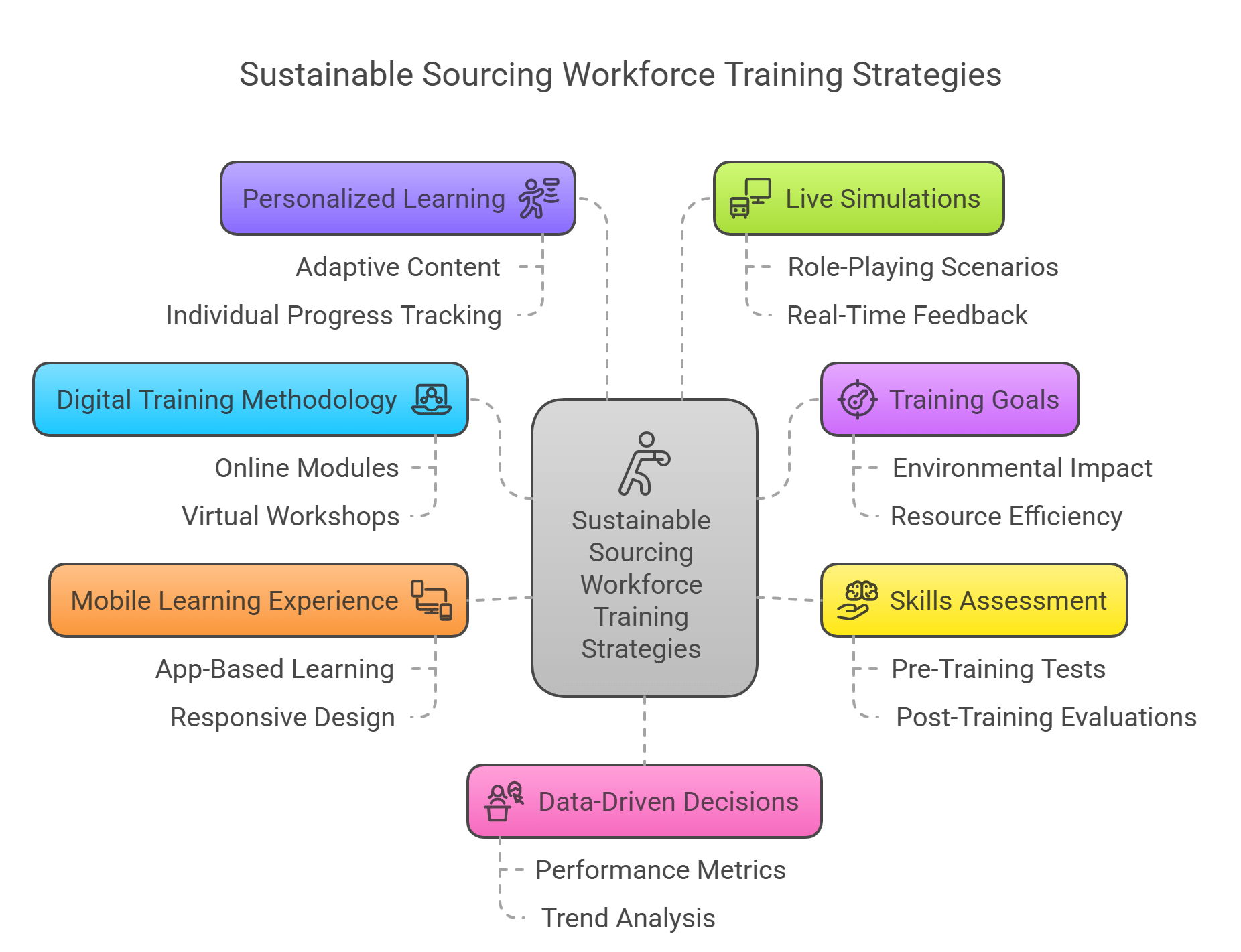
7 Key Sustainable Sourcing Workforce Training Strategies
Here’s a snapshot of how oil and gas companies can make their workforce training strategies robust, high-impact, and cost-effective.
1. Adopt a Digital Training Methodology
2. Identify Key Sustainable Sourcing Training Goals
Businesses must identify key learning outcomes that effectively equip the workforce training to adopt sustainable procurement practices. Once these are identified, the curriculum design must be aligned and optimized to help achieve these goals.
Business teams must execute training materials and methodology to meet sustainability goals, considering learning barriers, accessibility needs, and geographical concerns.
3. Assess Pre- and Post-training Skills Levels
To help optimize training impact, business teams must thoroughly assess existing skill levels. Knowing where the workforce training stands regarding knowledge and skills can help businesses deliver the right level of training, identify training outcomes, and define key measurability parameters.
Once the training is completed, participants must be tested on their skill levels to measure training success. Their performance on supply chain sustainability must be monitored and analyzed to determine further training needs.
4. Design a Mobile-First Learning Experience
Today’s learners are shifting towards mobile learning due to its convenience and flexibility. Access to mobile data and a basic smartphone enable a smooth learning experience. However, the learning experience must be optimized for a mobile-first experience, which includes optimization for low or no connectivity.
For instance, participants can easily access multimedia resources, attend live video conferences, and download eBooks and other multimedia resources. Mobile-based learning can nudge participants to engage in self-learning, practice more, and log in from anywhere, anytime, based on classroom schedules.
5. Personalize the Learning Experience
As job roles become more specialized, the tide shifts towards a highly personalized user experience. Hence, oil and gas companies must be able to personalize the learning experience for maximum impact.
Shifting from a legacy LMS to an AI-powered LMS can automate the personalization process. Companies can generate lessons and assessments according to a participant’s unique learning needs and challenges.
6. Enable Building Skills via Live Simulations
While understanding theory and fundamentals is essential, workforces must be able to apply their knowledge and skills in real-life situations. Businesses face a key challenge—preparing employees to respond optimally in various scenarios. Technologies like Virtual Reality (VR) and Augmented Reality (AR) have changed the training game to help meet this demand.
Businesses can now simulate multiple scenarios and enable employees to practice with diverse parameters. Benefits include a lack of financial and physical risks and unlimited practice within all permutations and combinations.
7. Leverage Data to Make Key Training Decisions
The measurability of energy sector sustainability training is an important aspect of the entire workforce training framework. A superior automated LMS comes with robust AI-based data analytics.
Businesses can track all aspects of participant engagement, analyze trends, and make data-driven decisions. They can also predict participants’ performance based on historical data. Training can be tweaked to suit individual strengths and needs.
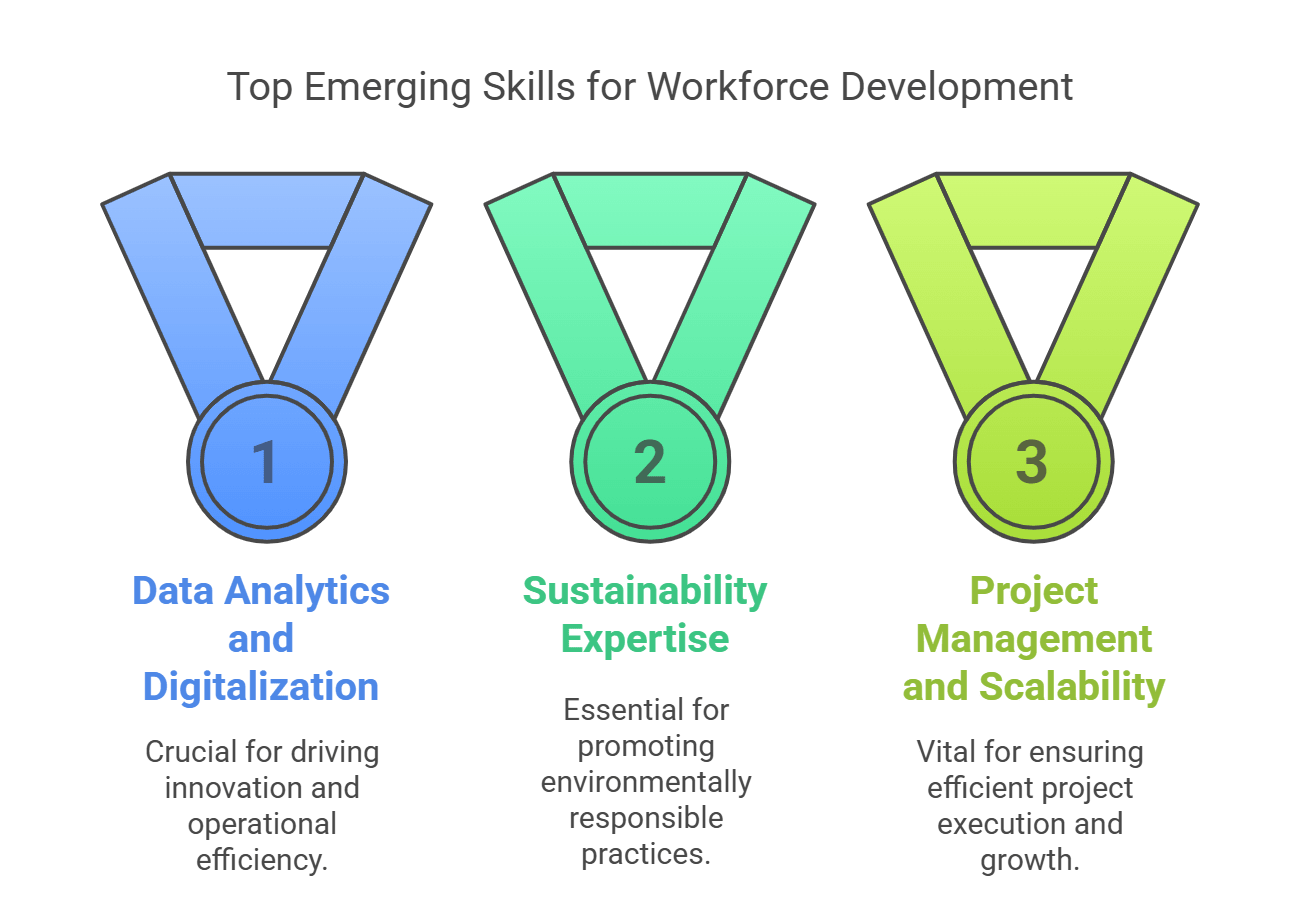
The Challenge: Skills Gap and Changing Needs
The energy transition necessitates a comprehensive reevaluation of the skillsets required within the Oil and Gas industry and workforce learning and development initiatives. While traditional expertise in areas like exploration and drilling remains valuable, it is no longer sufficient.
A new and multifaceted skills gap is emerging as the industry embraces cleaner energy sources.
To bridge this gap and ensure long-term success, oil & gas companies must prioritize the development of critical capabilities in several key areas:
1. Data Analytics and Digitalization
For example, wind, solar, and geothermal power significantly rely on data analysis to maximize efficiency and forecast energy production.
Conventional oil and gas workers might not be as adept at managing and interpreting data as they should be, which would limit their capacity to make meaningful contributions to the new energy environment.
In addition, the sector is rapidly changing due to digitalization. Integrating renewable energy sources into the system requires a thorough understanding of digital communication protocols and smart grid technology.
2. Sustainability Expertise
Sustainability initiatives are becoming increasingly significant in the energy sector.
Moreover, understanding carbon capture and storage technology and ways to reduce environmental effects is essential for conscientious growth in the renewable energy sector.
3. Project Management and Scalability
The workforce is critical to enabling scalability, a key determinant of success in the energy sector.
Energy firms require a staff capable of handling ever-more complicated operations as they grow both regionally and throughout various areas of the energy value chain.
Workers with a variety of skill sets, from data analytics to project management, are needed to guarantee the smooth integration of new assets, efficient processes, and the upholding of quality and safety standards on a large scale.
What is Soft Skills Training?
Soft skills development training enhances communication, teamwork, and problem-solving abilities. Other essential soft skills include emotional intelligence, a positive attitude, and creativity. Developing these skills in any industry is as crucial as training for technical skills.
Due to the growth of eLearning, the soft skills training market is expected to expand by USD 315.6 million between 2023 and 2028 at a compound annual growth rate (CAGR) of 50.98%. This increase emphasizes the necessity for efficient training programs and the growing understanding of the value of soft skills in professional development.
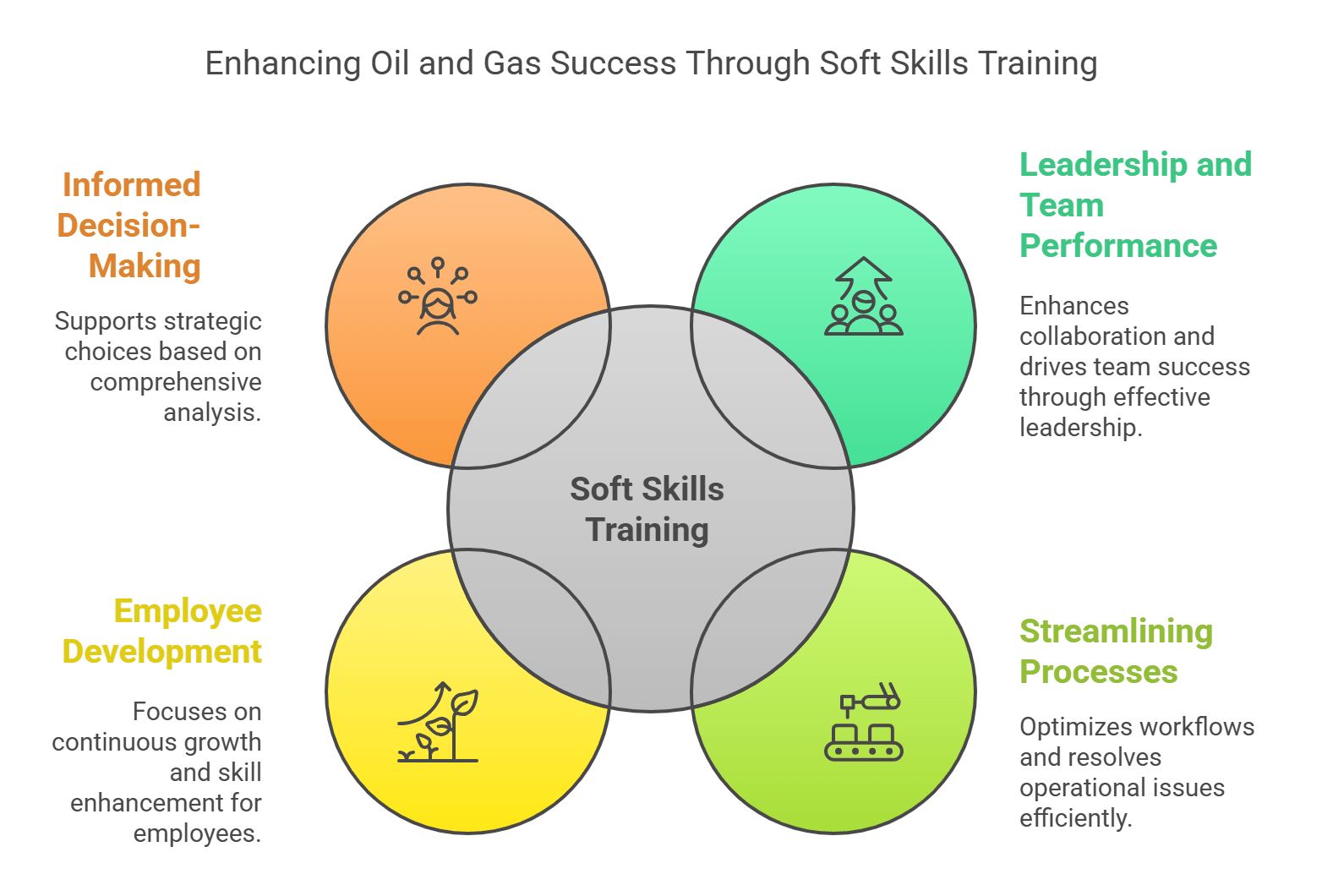
Importance of Soft Skills Training for Oil and Gas Professionals
Effective communication helps prevent accidents in the oil and gas industry. Workers must convey important information clearly, especially in high-pressure situations.
Here are some reasons why soft skills development should be an integral part of oil and gas training programs:
1. Leadership and Team Performance
Leadership soft skills are important to understanding employees’ needs, building valuable relationships, and enhancing team performance.
2. Streamlining Processes and Resolving Issues
Strong collaboration and effective communication streamline processes and resolve issues faster, minimizing errors and delays. For example, geologists, engineers, and rig crews who can communicate complex data can optimize efficiency during drilling operations.
3. Valuing Employee Development
Investing in soft skills training shows employees that their development is valued, which can improve staff retention. Moreover, developing listening and empathy skills is especially crucial when handling complex client issues.
4. Informed Decision-Making
Oil and gas operations can entail complex circumstances that call for well-informed choices. Developing soft skills is essential to evaluate scenarios, think through options, and make decisions that prioritize safety and compliance.
Essential Soft Skills for Engineers in the Oil and Gas Industry
Here are some essential soft skills for engineers:
- Communication: Strong communication skills help prevent misunderstandings, ensure safety, and enhance collaboration.
- Teamwork: Engineers must work closely with peers from various disciplines, including geologists and operations staff. Teamwork means working well with others and respecting diverse perspectives and expertise.
- Leadership Skills: Effective leadership skills in engineers build a positive work environment and drive performance. Leadership means applying emotional intelligence and the ability to manage conflicts.
- Problem-Solving and Critical Thinking: Engineers in the oil and gas sector should be well-trained to analyze complex problems. They should be trained to address equipment failures, unexpected geological formations, or market fluctuations.
- Emotional Intelligence: Emotional intelligence helps engineers manage their own emotions and empathize with others. High EI means better teamwork, leadership, and communication.
- Time Management: Efficient time management helps engineers maintain productivity and meet project deadlines. These professionals must prioritize tasks and manage their workload effectively.
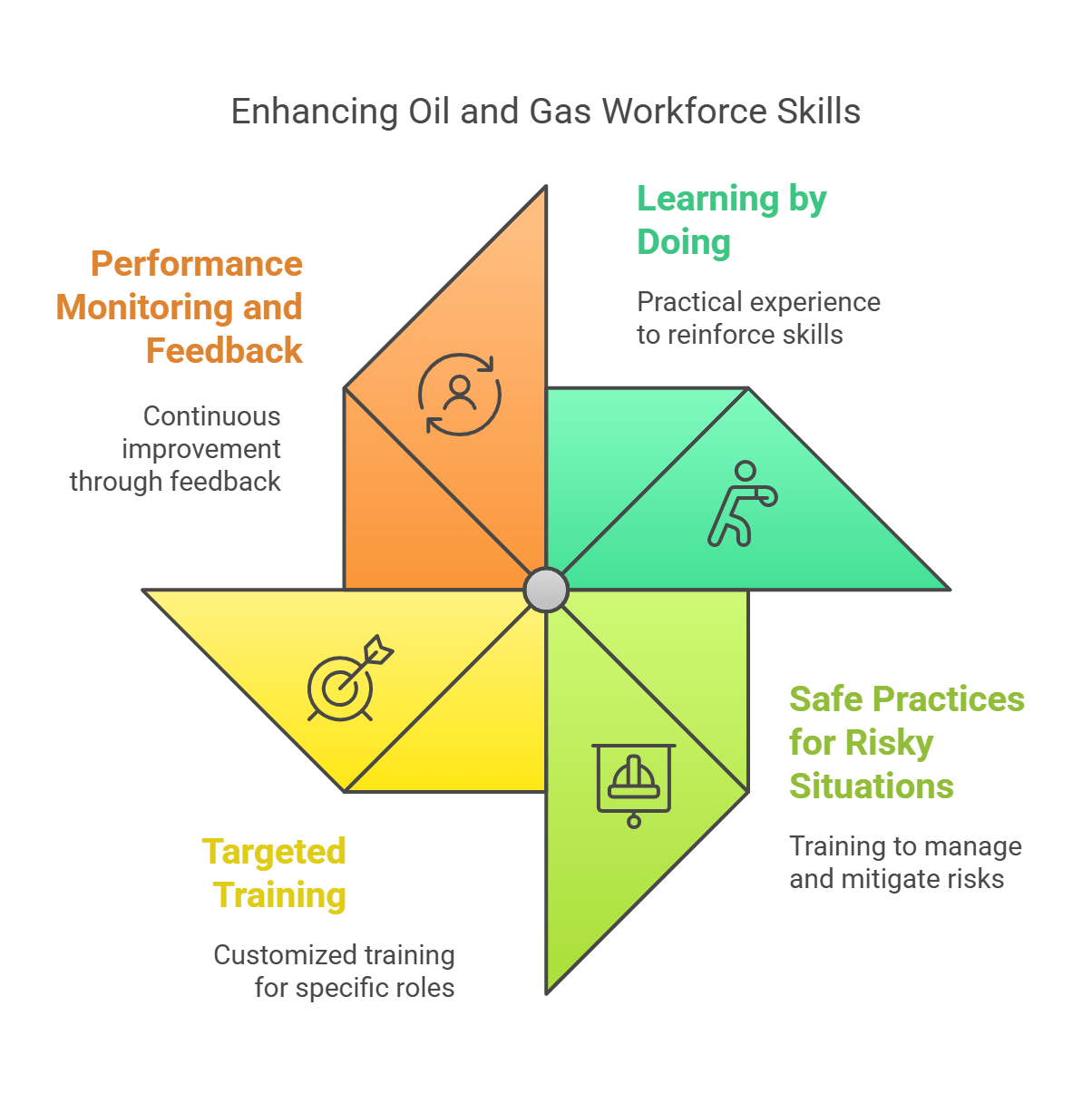
Industry-Specific Soft Skills for Oil and Gas Employee Training
Here are some oil and gas industry-specific soft skills that professionals should be trained on:
1. Learning by Doing
Virtual reality and simulation training programs help professionals deal with realistic scenarios. This allows them to experience the pressure and emotions of real-world situations. The hands-on approach helps them understand and apply soft skills effectively.
2. Safe Practices for Risky Situations
VR simulation soft skills training allows workers to handle complex scenarios and build their confidence in dealing effectively with dangers and emergencies.
3. Targeted Training
Oil and gas professionals in different teams should have access to customized versions of soft skills training. For instance, a rig engineer can focus on communication and delegation skills, and a seasoned engineer can work on conflict resolution. This ensures that workers develop the most relevant and necessary skills for their roles.
4. Performance Monitoring and Feedback
Trainers can monitor workers’ performance and provide feedback within the VR environment. Workers can identify their strengths and weaknesses and adjust their approach in future simulations.
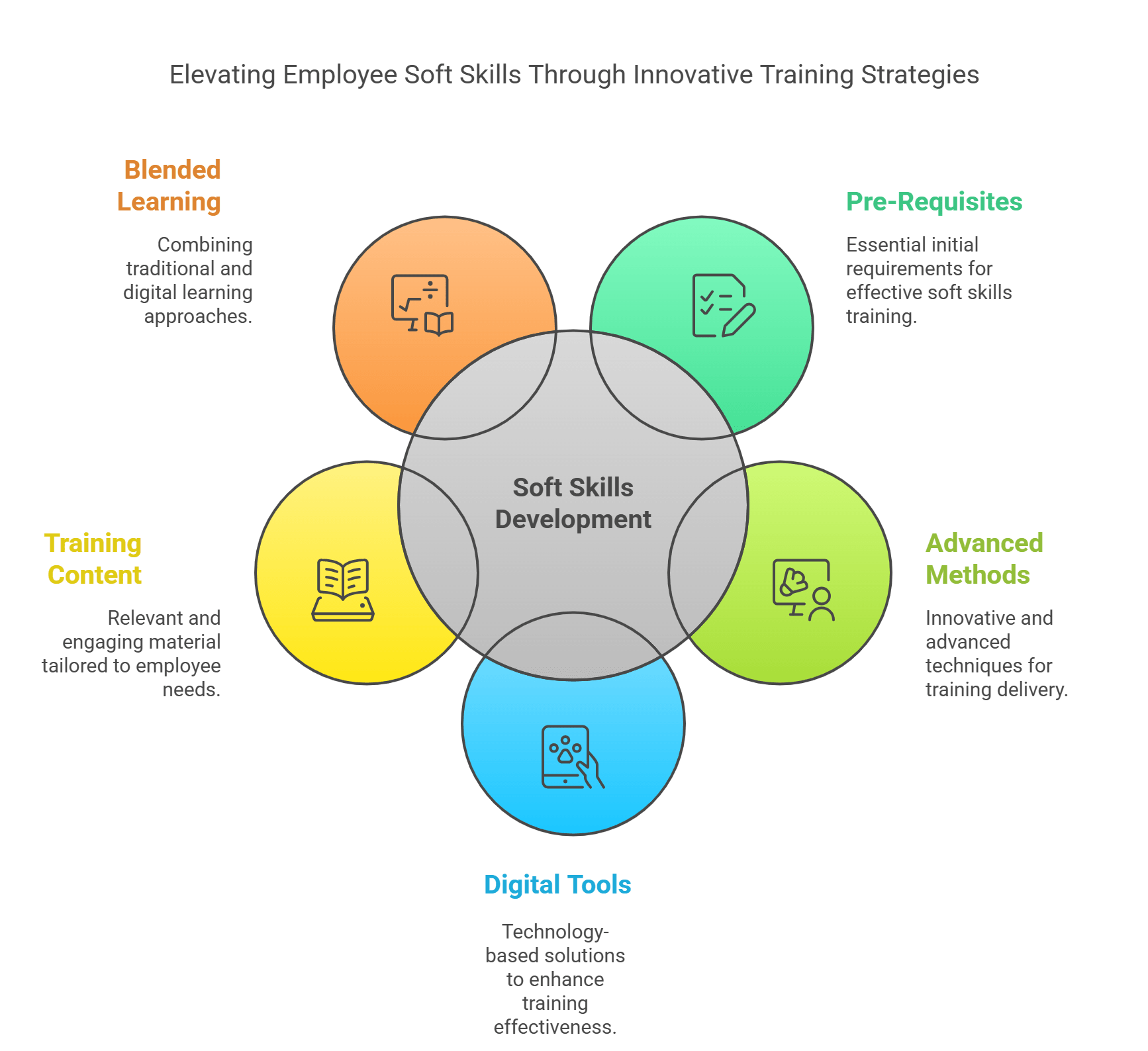
How to Enhance Soft Skills Development through Oil and Gas Employee Training Programs?
Identifying skill gaps and determining common soft skills that should be included in oil and gas training programs is essential.
Here are some key steps:
Step 1: Follow Pre-Requisites for Offering Soft Skills Training
This includes analyzing the best ways and training modules for soft skills development among professionals in the oil and gas industry. It includes:
- Scenarios or Case Studies.
- Interactive Videos.
- Social Polls.
- Assessments.
- Microlearning with performance support on mobile devices.
- Training Materials like fact sheets, workbooks, and eLearning modules
Step 2: Determine Advanced Training Methods
Decide on the format and delivery method for your soft skills training. Options include:
- Face-to-face training is practical for hands-on learning and interactive workshops.
- eLearning courses offer flexibility and allow oil and gas professionals to learn independently.
- Virtual Reality offers immersive training experiences by simulating real-world scenarios. This technology is helpful for practicing soft skills in high-pressure situations.
Step 3: Choose Appropriate Digital Tools
If you opt for digital soft skills training modules, select an authoring tool that meets your needs for developing soft skills. Consider your experience with eLearning tools, budget, and project complexity.
Step 4: Build Relevant Training Content
Use pre-built templates or create materials from scratch, engaging Subject Matter Experts from your L&D and HR teams. For effective results, use interactive formats like quizzes, branched scenarios, and videos to keep employees engaged.
Step 5: Apply Blended Learning Approaches
Businesses can organize one-on-one coaching sessions using a blended learning approach. This method might introduce a concept, followed by a face-to-face workshop for hands-on practice and VR simulations to reinforce learning.
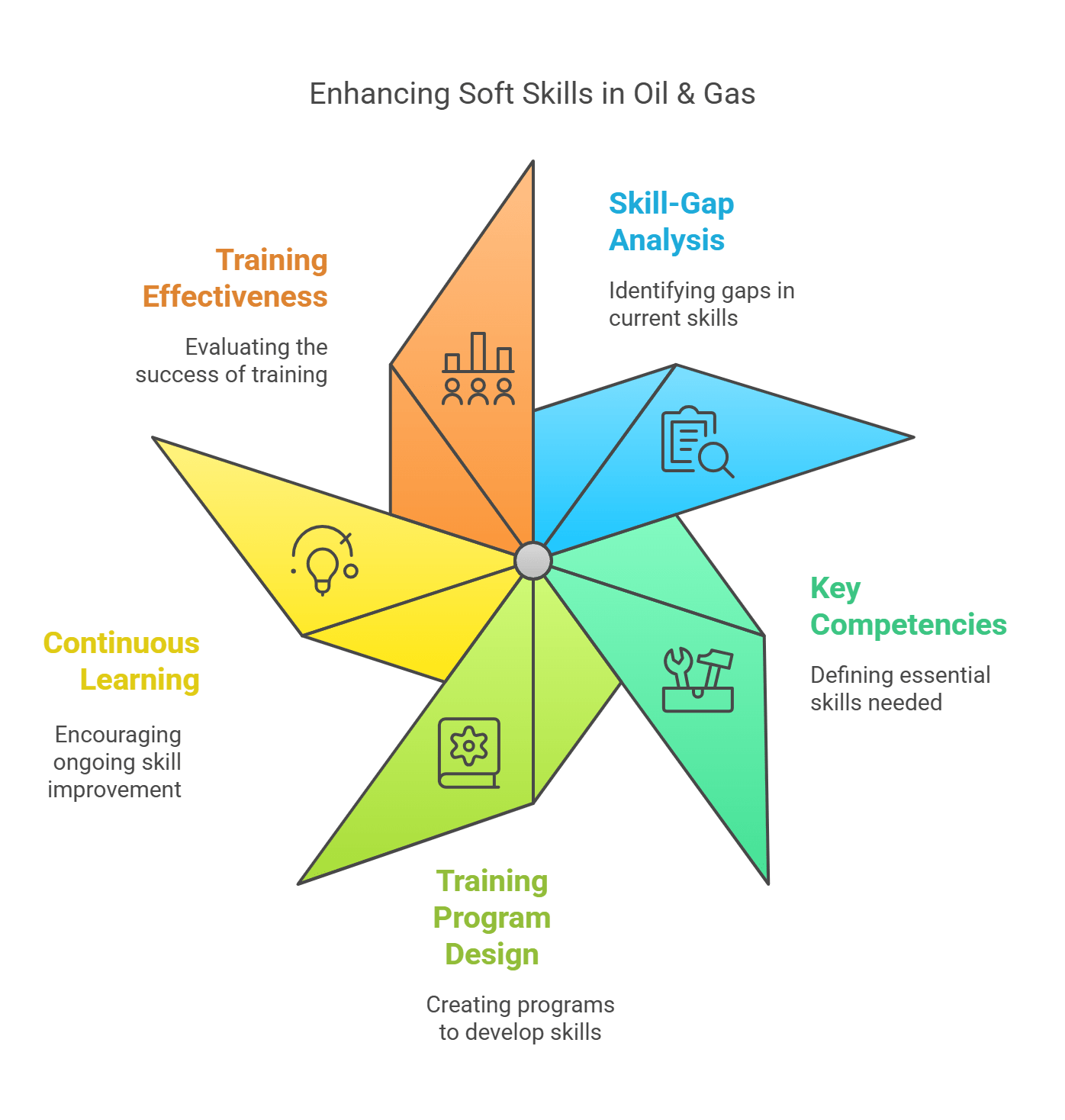
Best Practices for Soft Skills in Oil & Gas
Here are some best practices for inculcating soft skills in oil & gas professionals:
1. Conduct a Skill-Gap Analysis
Identify your organization’s specific soft skills gaps by conducting a comprehensive analysis. This involves:
- Collecting feedback from employees and managers about soft skills, strengths, and weaknesses.
- Analyzing performance reviews to identify soft skills deficiencies.
- Observing day-to-day interactions to pinpoint areas needing improvement.
2. Define Key Competencies
Based on the analysis, define the key soft skills competencies required for various organizational roles.
Common competencies in the oil and gas sector include:
- Conducting clear and concise information exchange
- Working effectively in diverse teams
- Inspiring and guiding teams for achieving organizational goals.
- Analyzing complex issues and making informed decisions.
3. Designing Soft Skills Training Programs
L&D heads must develop training content according to the unique needs of the oil and gas industry.
Consider incorporating:
- Real-world examples and case studies relevant to oil and gas operations.
- Training modules for different roles.
- Role-playing, simulations, and interactive exercises.
- A blended learning approach.
4. Continuous Learning and Development
Encourage a culture of continuous learning by providing ongoing training and development opportunities.
This can include:
- Regularly scheduling courses to update soft skills.
- Pairing employees with mentors to provide guidance
- Encouraging peer learning through collaborative projects.
5. Measuring Training Effectiveness
Conduct assessments before and after the training to measure improvements in soft skills. Implement feedback mechanisms to improve the training programs continuously.
This can include:
- Feedback from participants about their training experience.
- Focus groups to gather in-depth insights and suggestions for improvement.
- KPI measurement is related to soft skills.
- Regularly update the training content and methods to reflect the latest industry trends and best practices.
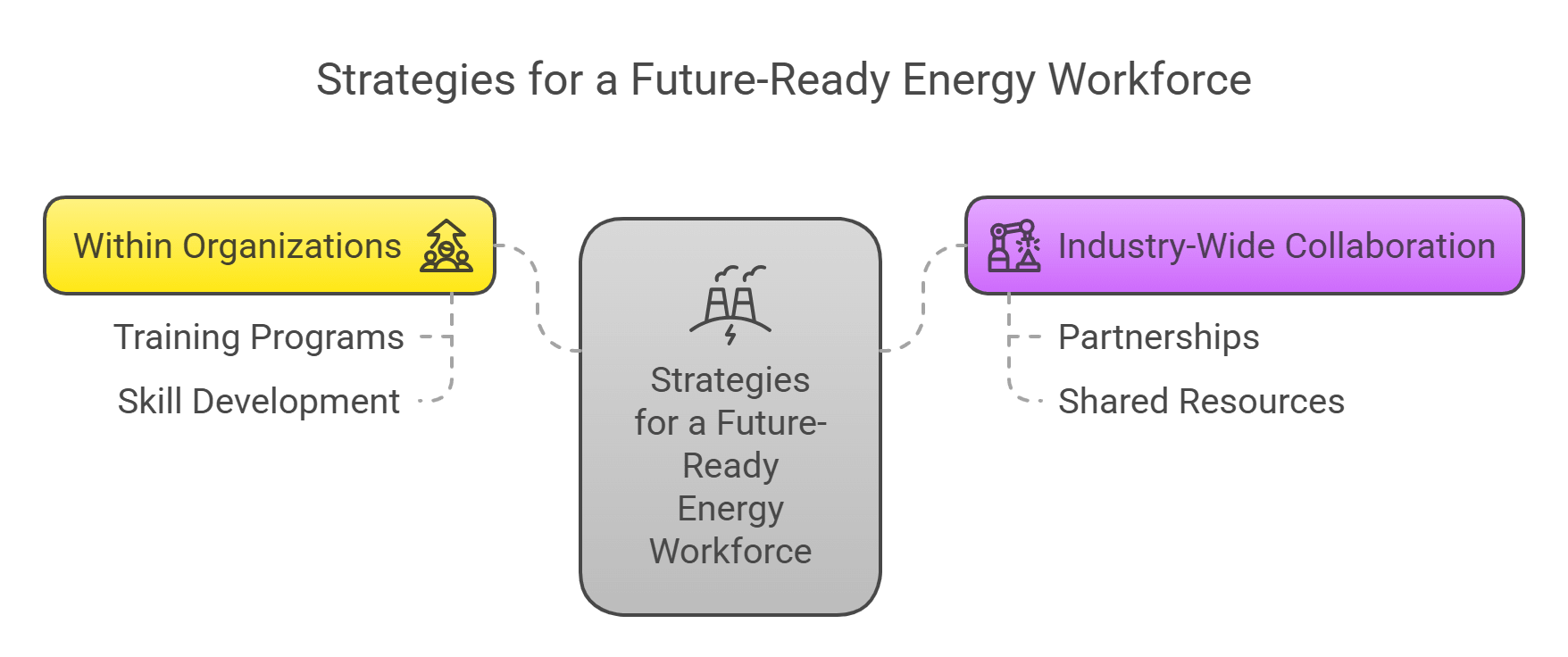
Strategies for a Future-Ready Energy Workforce
Upskilling current employees and attracting new talent with experience in renewable energy are crucial components of the oil and gas industry’s successful workforce transformation plan.
When applied at the corporate and sectoral levels, these tactics enable the energy sector to develop a more inclusive, varied, and flexible workforce.
1. Within Organizations
Here’s a snapshot of how organizations can strategically prepare their workforce for the future:
- Future-Back Workforce Planning: Companies must proactively use strategic workforce planning. It involves carefully analyzing workplace transformation strategy, market demand, and current attrition trends to pinpoint the skills and talent required for the future. Businesses can utilize this data to prioritize efforts in upskilling and guarantee that they are developing a workforce capable of tackling upcoming challenges.
- Leadership for Change: Executive leadership must be firmly on board to cultivate a diverse and inclusive workforce. It necessitates a unified commitment to quantifiable DEI goals, a clear understanding of the need for change, and the establishment of measurable targets. To provide a clear grasp of the business case for change and to build an inclusive culture, effective leadership necessitates a blend of empathy and rationality.
- Upskilling and Capability Building: Successfully bridging the skills gap demands investment in workforce learning and development. Human resources, cultural leaders, and managers need sharper capabilities to identify skill gaps, promote inclusive behaviors, align systems, and nurture empathetic leadership skills.
- Building the Infrastructure for Progress: Tracking progress and encouraging accountability are crucial. Organizations should establish dedicated DEI teams and committees, implement data collection and measurement systems, and tie executive incentives to DEI goals.
2. Industry-Wide Collaboration
Here’s a glimpse of how industry-wide collaboration can further enhance the readiness of the energy workforce for the future:
- Cross-Industry Collaboration on DEI: The Workforce Energy project of the International Association of Oil & Gas Producers is a paradigm for industry-wide cooperation on DEI initiatives. Businesses that join this effort can pool their resources and expertise, exchange best practices, and work together to solve the skills shortage.
- The DEI Metrics are Standardized: Companies can benchmark their progress and pinpoint areas for improvement by establishing clear, standardized DEI criteria with minimum commitments and transparency expectations. This common framework encourages responsibility and promotes advancement within the sector.
- Sharing Best Practices: Openly sharing best practices for attracting and retaining a diverse workforce benefits the entire industry. Treating this as a collaborative effort with shared opportunities allows companies to learn from each other’s successes and accelerate progress.
- Monitoring Infrastructure for Public Accountability: Establishing a monitoring infrastructure is essential for maintaining public trust and holding businesses accountable for their DEI promises.
- Sustainability Focus: The sector’s potential to thrive in the future depends on its dedication to sustainable solutions. Prospective employees who value working for organizations with a positive impact will be impressed by a focus on environmental responsibility.
- Workforce as the Core: The industry’s success revolves around its workforce, which is considered its core. Prioritizing human-centric methods that encourage a healthy work environment and promote employee well-being is necessary to retain qualified staff.
Wrapping Up
The energy sector is at a critical juncture today.
The industry can seize the opportunity to establish leadership in sustainable practices and future-proof its workforce by adopting sustainability as a fundamental concept and integrating those principles into its talent strategy.
A successful transformation of the energy workforce requires a collaborative effort. A workforce training consulting firm may help businesses navigate the energy transition by creating a talent pool that is prepared for the future and upskilling their employees.
At Hurix Digital, we prioritize acquiring the abilities needed to succeed in the clean energy industry.
Our forward-thinking workforce transformation services guarantee a knowledgeable and flexible workforce ready to handle the challenges of a low-carbon future and pave the path for a more sustainable society.
Contact us now!

A highly enthusiastic and motivated sales professional with over twenty five years of experience in solution selling of training-related applications and services. Maintains an assertive and dynamic style that generates results. Ability to establish long-term relationships with clients built on trust, quality of service and strategic vision. Specializes in financial services, higher ed, publishing and government in the areas of learning and development.
